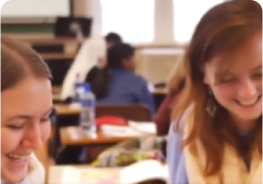Celebrating Easter
by Prof Salvador Ryan
Home / Celebrating-easter

Celebrating Easter
As we prepare to recall the story of Christ’s passion and death in these days leading up to the great season of Easter, it may be worthwhile to reflect on the rich tradition of religious folklore which has been bequeathed to us over many centuries. Irish folktales which recount the story of Christ’s passion, death and resurrection – and which often co-opt familiar figures from ancient heroic literature in its central casting, not to mention having the characters use Irish expressions in their dialogue – are part of what might be called the world of “vernacular theology”, which often seeks a domestication of the divine. These stories and traditions not only animated the imaginations of those who heard them, but they also often provided some homespun explanations for features of the everyday world.
In addition they often sought to supply additional material which succeeded in “filling out” the back-stories of characters who appeared only in brief in the gospels. One such story concerns the Virgin Mary and the Child Jesus who were out walking one day in a wild wood. Feeling tired, they happened upon a small shack in the woods and entered it to find a woman boiling a saucepan of milk over the fire for her own child. Welcoming the visitors, she gave half the saucepan of milk to her young boy and kept the rest back to give to the Child Jesus. The Virgin Mary thanked her and went on her way. Years later, when on a Friday afternoon Jesus found himself hung on a cross between two thieves, it just so happened that the thief on his right, who asked to be remembered in Christ’s kingdom, was the child whose milk he had shared all those years ago!
Christ’s death on Calvary on Good Friday was considered to be so momentous that for some it was utterly unthinkable that there wouldn’t be an Irish connection to this event somewhere. And thus the story of Irishman, Conall Cearnach’s witnessing the death of Christ became very well known. Conall’s background was as a member of the legendary Fianna and, so the story went, as a result of an internal battle, he left Ireland to join the Roman army. Before he left, he had been a gregarious, outgoing sort of chap, but upon his eventual return he had transformed into a silent, surly fellow with an air of gravity about him. Upon enquiring the cause of this change of character, he told a friend that he had once witnessed the crucifixion of a man, whose death precipitated the fall of a great darkness upon the earth. Thereafter the people concluded that it was Christ’s death which Conall had witnessed that day. But there were other traditions which also suggested an Irish presence on Calvary when Christ was crucified. One of these pointed out that the titulus board which proclaimed in mockery “Jesus the Nazarene King of the Jews” in three languages (Latin, Hebrew and Greek) was quadrlingual rather than trilingual. After all, the tradition claimed, don’t the words “IN RI” translate as ‘The King” in Old Irish? Thus, it was claimed, had the Irish dispensed with the acronym, proclaiming Christ king on the cross with heartfelt faith while simultaneously checking off another unique Irish contribution to world history.
In Irish religious folktales the events of Holy Week were also employed to provide explanations for many natural phenomena such as why a myrtle bush never grows very tall (because the scourges which were used on Christ were supposedly taken from this plant); why the cedar is cursed (because its wood was used in the making of Christ’s cross and thus “they say that if you took a sheaf or a slip off it with a knife that it has a smell that you won’t get from any other wood and that it shouldn’t be used to roof a house or for any other use”); and why the lark was considered to be “loyal” (because it had removed the nails from Christ’s hands on the cross) and, famously, why Irish cockerels don’t cry “cock-a-doodle-do.
This last tradition arises from the story of the cock and the pot (which often appear together on Irish penal crosses). Variously (depending on the version) either Pilate or Judas returns to his home after Christ’s death to find his wife cooking a rooster in a pot. She is distressed and explains that she had a dream in which the man who had just been put to death rose from the dead. Pilate (or Judas) dismiss her concerns immediately, scoffing at her words by saying “there’s as much chance of that man rising from the dead as there is of that cock leaping out of the pot”. And, sure enough, the inevitable happens: the cock leaps from the pot and cries “Mac na hÓighe slán!” (“the Virgin’s Son is safe/alive”) which is what Irish cockerels have apparently cried ever since!
One of the most colorful of Irish Easter folk traditions, however, must be that concerning the origin of tobacco. This tale relates how on Easter Sunday morning the Virgin Mary came to Christ’s tomb to find it empty. Fearing for the whereabouts of her Son’s body, she becomes quite agitated. At this point an angel appears and assures her that all is well. However, owing to her anxiety Mary cannot fully take these words in and continues to shake in fear. Seeing her distress, the angel rolls some leaves together into a cylindrical shape, lights it and passes it over to Mary, saying, “have a try of this and see if it helps”. As Mary puts the strange lighted object to her lips, she experiences herself relaxing and a great calm comes over her. “What is this thing?’ she asks. “It’s tomb-bacco”, the angel explains. The story concludes with the observation that, because of its origins, tobacco was for many of its early years known as tomb-bacco and the Mother of God was its first consumer.
Irish religious folktales such as these, which filled out in colorful – and often humorous – ways the gospel accounts concerning the Easter event wouldn’t be forgotten in a hurry!

Prof. Salvador Ryan
Professor of Ecclesiastical History

If you live outside Ireland, check out our dedicated area for international students.
Let’s talk
For Undergraduate queries: email admissions@spcm.ie.
For Postgraduate queries: email pgadmissions@spcm.ie.
For The Centre for Mission & Ministries queries, email: cmmadmissions@spcm.ie.
